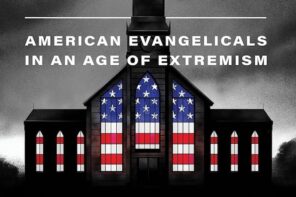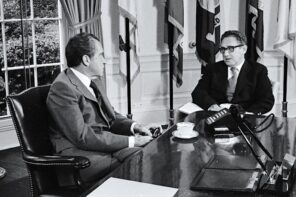A recently-opened “national” memorial museum depicts historic horrors. A controversial film suggests the culpability of religious concepts and adherents. Scholars and religious leaders appeal for review and re-editing.
These sentences set the stage not only for the debate over “The Rise of Al-Qaeda,” the short, six-minute film at the new National September 11 Memorial & Museum in New York, but for an analogous controversy seventeen years prior about a film on Christianity’s relationship to antisemitism at the United States Holocaust Memorial Museum in Washington, D.C.
At present, 9/11 Memorial President Joe Daniels has refused to consider any edits that would add the context and definition suggested by the museum’s Interfaith Advisory Group. He told the BBC, “There is no chance that that video is ever going to change.” But, in the earlier case at the Holocaust Museum, the institution did eventually reconsider, re-edit the film, and make changes. The 9/11 Museum, in line with its explicit mission to “inspire an end to hatred, ignorance, and intolerance,” should explore the same.
At the start of the permanent exhibition of the Holocaust Museum, which opened in 1993, visitors are given the option to watch two approximately fifteen-minute introductory films: “The Nazi Rise to Power,” which sets the historical and political context, and “Antisemitism,” which grounds Nazi antipathy toward Jews within a larger “anti-Jewish tradition of Christianity.”
In late 1997, a collection of conservative Jewish intellectuals and political figures—Michael Horowitz, Elliott Abrams, Chester E. Finn, Michael Ledeen, David Dalin, and Michael Medved—wrote a detailed, five-page letter to museum director Walter Reich arguing that the “Antisemitism” film spread “libels of Christianity,” ignored the religion’s “historic effect… [of] democratizing and civilizing,” and did not incorporate other scholarship suggesting Nazi antisemitism was categorically different from that of medieval Christianity.
They were soon joined in their advocacy by prominent Christians including William Donohue, President of the Catholic League; evangelical leader Chuck Colson; and David Neff, editor of Christianity Today. Judith Miller of The New York Times wrote a story about the letter in January 1998, and she quoted Rabbi Michael Berenbaum, a key founder of the Holocaust Museum, as suggesting that the authors sent it consciously “to show the evangelical right how credible they are.” Interestingly, several of the original signers would soon visibly anchor the so-called “neoconservative” Republican wing that influenced the military actions after the September 11, 2001 attacks. In this 1997 letter, the group argued that this core, orienting film in the Holocaust Museum should “note Islam’s theology and its often violent practice of anti-Semitism.”
While this last suggestion was rather inappropriate given the film’s context of European genocide, several of the letter’s objections were fair and reasonable. The authors criticized a phrasing that insinuated that Hitler’s view of “racial struggle” was tied to his being “Austrian-born and baptized a Catholic.” In an additional problematic maneuver that pieced together two separate statements, the film uncritically quoted Hitler as saying, “I am acting for the Lord. The only difference between me and the church is that I am finishing the job.” The letter further critiqued how the script did not explore Hitler’s or the Nazis’ manipulation of religion or offer any counter-narrative of how dehumanization and acts of genocide are condemned by other strands of Christian theology.
Initially, as the controversy became a topic for polemic in national magazines such as The New Republic, the museum declined to consider any changes. In April 1998, a spokesperson argued that the film, produced and written by Sandra Wentworth Bradley, had been “reviewed by the 17-member museum’s church-relations committee, which consists of theologians and historians both Protestant and Catholic.”
Eventually though, permanent exhibition curator Steven Luckert emailed Michael Horowitz to say that the museum would engage in what the National Catholic Reporter described as “an extensive review.” With little fanfare, in the spring of 2000, the museum began to screen a re-edited version of the film, removing the insinuation about Hitler’s Catholic background and deleting the controversial stitched quotation completely. For unknown reasons, the museum also apparently removed or altered a line in which the narrator, Halo Wines, warned: “This [the Holocaust] is where prejudice can lead.” The film in its current form is viewable on the Holocaust Museum website. While it is still quite firm in arguing that the Holocaust has defined origins in Christian antisemitism, the museum’s willingness to alter the most problematic sections made the controversy largely evaporate in the years since.
The 9/11 Museum’s decisions make potential resolution more complicated. Unlike the Holocaust Museum, which was able to say that its Christian religious advisors had vetted “Antisemitism,” the 9/11 Museum has ignored the unanimous advice of its own Interfaith Advisory Group—Christian, Muslim, and Jewish—that was tasked to review the Al-Qaeda film in late 2013 after concerns were first raised at a June 2013 “Conversation Series” meeting of various stakeholders.
Further, while the Holocaust Museum explicitly notes their film’s academic advisors of Paul van Buren, James H. Harris, and Michael Olmert on a sign at the entrance of the alcove for screening, the 9/11 Museum has not detailed its process of academic vetting for the film or for the permanent exhibition’s content on “Islamism,” “jihad/jihadism,” “Islamic law,” and Al-Qaeda. As a result of this opacity, the museum received a letter requesting outside review from over 400 scholars of religion, political science, and Islam.
Moreover, in the 9/11 Museum, the premise that Al-Qaeda is the product of a political movement labelled “Islamism” that seeks “the rule of Islamic law” is not merely the subject of a single film, but is a central, orienting message of the museum. The thirteenth word of a summary paragraph as one walks into the first hallway is “Islamist,” a term of art that is not necessarily defined in the same manner by the general public as by scholars. Recklessly, no definition is even hinted at until hours later on a small panel, after visitors have traversed emotionally overwhelming exhibits about a day of horror.
In contrast, the Holocaust Museum makes a determined effort to offer full historical context before the permanent exhibition’s journey begins. The 15-minute “Nazi Rise to Power” film (with the museum auditorium’s longer 38-minute extension, “The Path to Nazi Genocide“) offers wide-ranging historical context, including the end of World War I, Versailles, hyperinflation, fears of communism, the failings of the Weimar Republic, effects of industrialism, and changing societal mores.
“The Rise of Al-Qaeda,” on the other hand, begins with a short, context-free definition of “groups known as Islamists,” burns through an array of undefined and inconsistent religious terminology, and ends with the blunt statement that Al-Qaeda seeks a sinister-sounding “rule of Islamic law.” The 9/11 Museum, in both its film and paneled exhibition, assumes wrongly and ahistorically that the motivational and propaganda statements of Al-Qaeda, with their inherent subjectivity, can be taken at face value; the Holocaust Museum, in its ultimate removal of Hitler’s Christian quotations and general preference for detailed historical context, provides the better approach.
The civil rights organizations—Sikh, Arab, Muslim, and South Asian—now critical of the 9/11 Museum’s decisions have more at stake than Christian groups did during the “Antisemitism” film controversy. At that time, Robert Royal, vice president of the Ethics and Public Policy Center, explained the general ambivalence: “As far as criticism of Christianity, we’re not as sensitive because, maybe, we tend to feel, Christianity has lasted for centuries and will last for centuries, so why bother…. We don’t have as much investment in the whole question of the Holocaust as the Jewish community does.”
While well-aware that many sensitive political issues emerge from public discussion of how to present the origins of Al-Qaeda, the various Sikh, Arab, Muslim, and South Asian organizations stand resolved to challenge the film because any possible impression of collective responsibility for the 9/11 attacks at such an influential institution will present immediate life-and-death concerns. These fears must not be minimized, dismissed, or politicized. Four days after 9/11, because he was wearing a Sikh turban, Balbir Singh Sodhi was assassinated in Phoenix, Arizona while pumping gas. More recently, in 2012, six people were killed and four wounded in a massacre shooting at a Sikh temple in Wisconsin.
Toward the end of the month-long period when an array of civil rights organizations had been refused permission to view “The Rise of Al-Qaeda,” Amardeep Singh of the Sikh Coalition, a national organization advocating “civil and human rights for all people,” pleaded:
I think part of the problem is that the board of trustees, the leadership of the museum, they’re not from our communities…. When I have to worry when there’s an attack somewhere out there, and it’s associated with Islam, in some way. When I have to worry about my personal safety walking the streets of this city…. That’s not an experience that anyone associated with this film has ever had. It’s so easy to be flippant about somebody else’s rights. It’s so easy to not take into consideration those who are not you or from your family. But that’s not what America is about. We stand together. And on 9/11, as a country, we stood together. And this memorial, and the film that is shown, must be about us standing together. I’d ask the people who put together this film, I’d ask each and every Board of Trustees member of this museum to one day tie a turban, grow out a beard, watch that film with other Americans and see how it makes you feel…. This is about the story of what it means to be American, and about how this museum can bring us together as a country. And when we’re together, we are defeating terrorism. We are defeating the people who want to drive us apart as a country…. The edits that have been suggested by this coalition are modest. They’re fair. Please, give us an opportunity. This could be a historic mistake.
Now that the museum is open to visitors, informed review of the film (including its uncontextualized imagery of people with turbans and beards) and of the paneled exhibit on Islamist ideology has led Amardeep Singh and other civil rights advocates to fear that we may soon witness violent attacks and murders by individuals whose assignment of collective guilt is strengthened by visiting the museum and by consuming its incomplete and misleading content on Islam.
These fears of the institution’s effect are magnified by the awareness that one of the key members of the board of directors, who serves on the crucial 11-person “program committee” that approves exhibition content, has argued publicly that Islam is “a transnational threat”; that “Islamophobia” is a “made-up term”; and that there is “no such thing as an irrational fear of Islam or Muslims.”
With the dismissal of the concerns of its Interfaith Advisory Group, the September 11 Memorial Museum has needlessly and carelessly politicized an institution that should offer unity. However, compromise solutions can still be found. The museum can put some things back on the table, engage a committee of leading scholars to rethink and revise its exhibits on the historical and political context of Al-Qaeda, and redo its film to offer the level of historical context that the Holocaust Museum provides.
The current director of the September 11 Memorial Museum, Alice Greenwald, spent many years as an Associate Museum Director at the Holocaust Museum which hosts a special exhibition curated by Susan Bachrach titled “Some Were Neighbors” that raises many important questions about how to parse delicate claims of collective responsibility. Greenwald and her colleagues can learn from the experience of the Holocaust Museum in handling controversial issues related to religion and to the assignment of collective responsibility—and in never being so rash and irresponsible as to declare that there is “no chance” that anything, even a prominent film, “is ever going to change.”




